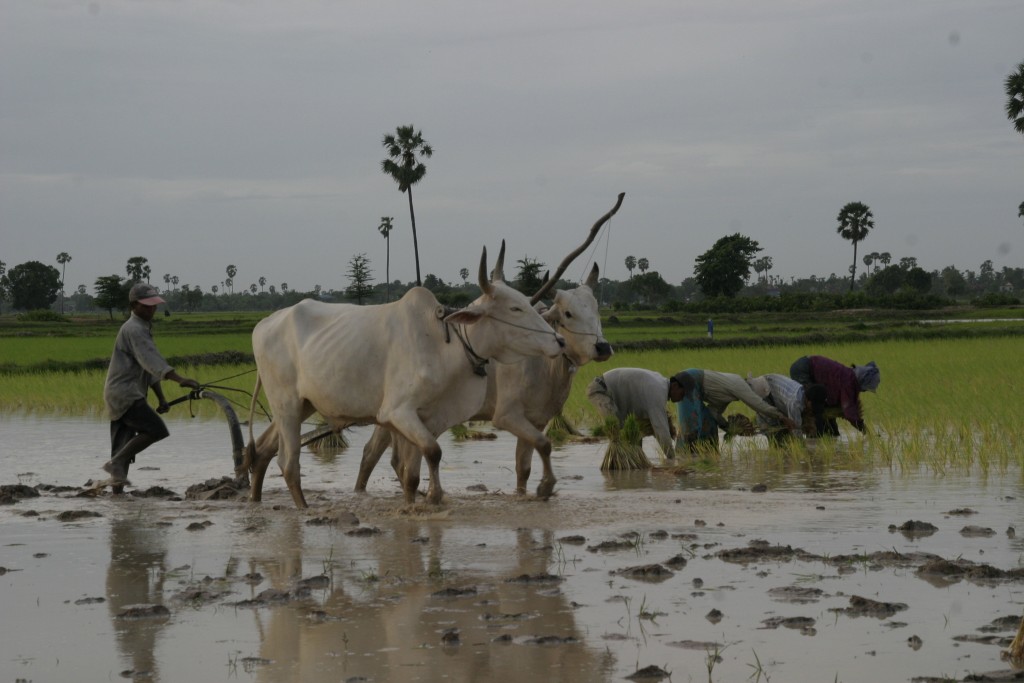
កសិករកំពុងធ្វើការនៅវាលស្រែ ខេត្តកណ្តាល នៃប្រទេសកម្ពុជា។ រូបភាព ថតដោយ ILO/ ខឹម សុវណ្ណារ៉ា, ១២ កក្កដា ២០០៧។ អាជ្ញាប័ណ្ណ CC BY-NC-ND 2.0
វិស័យកសិកម្ម នៅតែបន្តដើរតួនាទីយ៉ាងសំខាន់ក្នុងសេដ្ឋកិច្ចរបស់ប្រទេសកម្ពុជា ប៉ុន្តែនាពេលបច្ចុប្បន្ននេះ វិស័យនេះផ្ដល់នូវជីវភាពរស់នៅដល់ប្រជាជនក្នុងទំហំសមាមាត្រតូចជាងពីពេលអតីតកាល។ ការសិក្សាមួយពីក្រសួងកសិកម្ម ដែលបានចេញផ្សាយនៅក្នុងខែមិថុនា ឆ្នាំ ២០១៧ បានរកឃើញថា សព្វថ្ងៃនេះ ចំនួនប្រជាជនដែលធ្វើកសិកម្មមានប្រមាណជា ៤០ ភាគរយ ដែលចំនួននេះបានធ្លាក់ចុះពី ៨០ ភាគរយនៅក្នុងឆ្នាំ ១៩៩៣។1 ស្រូវអង្ករ មកទល់នឹងពេលនេះ គឺនៅតែជាផលិតផលសំខាន់បំផុត ដែលវាបានធ្វើឱ្យការចូលរួមចំណែកវិស័យកសិកម្មដល់ផលិតផលក្នុងស្រុកសរុប (GDP) កើនឡើង ៦០ ភាគរយ។2 ការនេសាទត្រីនិងជលផល ក៏ជាគ្រឹះមួយដ៏សំខាន់នៃសេដ្ឋកិច្ចជនបទរបស់ប្រទេសកម្ពុជា ដោយផ្តល់នូវប្រូតេអ៊ីនប្រមាណ ៨០ ភាគរយ នៃប្រូតេអ៊ីនសត្វនៅក្នុងរបបអាហារជាទូទៅ។3
គោលនយោបាយកសិកម្ម
ក្រសួងកសិកម្ម រុក្ខាប្រមាញ់ និងនេសាទ ជាស្ថាប័នដែលទទួលខុសត្រូវចំពោះការត្រួតពិនិត្យលើ វិស័យ ទាំងនេះនៅក្នុងប្រទេសកម្ពុជា។ ចាប់តាំងពីពេលចេញផ្សាយយុទ្ធសាស្ត្រចតុកោណ ជាលើកដំបូង រដ្ឋាភិបាលកម្ពុជាបានផ្ដល់អាទិភាពលើវិស័យកសិកម្មដែលជាវិស័យសំខាន់មួយសម្រាប់ការអភិវឌ្ឍ។ កំណែទី III នៃយុទ្ធសាស្ត្រនេះមានគោលបំណងជំរុញឱ្យមានការវិនិយោគក្នុងវិស័យកសិកម្មលើសពីការពង្រឹងប្រាក់ចំណូលនៅតាមជនបទ ទៅកាន់ការអភិវឌ្ឍបច្ចេកវិទ្យាឱ្យមានភាពប្រសើរឡើង នូវការស្រាវជ្រាវនិងការអភិវឌ្ឍ ការធ្វើពិពិធកម្មដំណាំ និង ការផ្សព្វផ្សាយផលិតកម្មពាណិជ្ជកម្មនិងកសិឧស្សាហកម្ម។4
នេះជាសញ្ញានៃការផ្លាស់ប្តូរពីកសិដ្ឋានក្រុមគ្រួសារខ្នាតតូច ទៅកាន់កសិឧស្សាហ កម្ម។ និន្នាការនេះអាចធ្វើទៅបាន ដោយផ្នែក បន្ទាប់ពីរដ្ឋាភិបាលអនុញ្ញាតឱ្យក្រុមហ៊ុនឯកជន ជួលដីទ្រង់ទ្រាយធំ តាមរយៈការផ្តល់អាជ្ញាប័ណ្ណទៅលើសម្បទានដី សេដ្ឋកិច្ច (ELC)។ កសិកម្មតាមកិច្ចសន្យា និងការជួលដីឯកជន ជាមធ្យោបាយផ្សេងទៀតសម្រាប់ពង្រីកវិស័យកសិឧស្សាហកម្ម។
ខណៈពេលដែលរដ្ឋាភិបាលរំពឹងថា វិស័យកសិកម្ម នឹងកើនឡើង ៤ ភាគរយ ក្នុងមួយឆ្នាំ រហូតដល់ឆ្នាំ២០១៨5 នេះជាអត្រាមួយយ៉ាងទាប ធៀបទៅនឹងវិស័យឧស្សាហកម្ម ឬ វិស័យសេវាកម្មនានា។ ជាទូទៅ វិស័យកសិកម្ម ត្រូវបានគេចាត់ទុកថាមានភាពទន់ខ្សោយ6 ដោយមានការការធ្លាក់ចុះ រហូតដល់ ១-២ ភាគរយរវាងឆ្នាំ ២០១៣-២០១៤7 បានទទួលរងផលប៉ះពាល់ដោយសារ ផលិតភាពទាប ភាពងាយរងគ្រោះដោយទឹកជំនន់ និងគ្រោះរាំងស្ងួត ព្រមទាំងហេដ្ឋា រចនាសម្ព័ន្ធមិនទាន់គ្រប់គ្រាន់8 និង ការធ្លាក់ចុះនៃគុណភាពដីនៅតំបន់មួយចំនួន។9
កត្តាទាំងនេះ បង្ករឱ្យមានផលប៉ះពាល់ផ្សេងៗគ្នាសម្រាប់កសិកម្មប្រភេទផ្សេងៗគ្នា។ កសិដ្ឋានបែបក្រុមគ្រួសារកសិកម្មខ្នាតតូច នៅប្រទេសកម្ពុជា ពឹងផ្អែកលើទឹកភ្លៀង ការប្រើប្រាស់គ្រាប់ពូជដើម និងអាចមានលទ្ធភាពទិញវត្ថុធាតុដើមមួយចំនួនតូច។ កសិករប្រភេទនេះផលិតសម្រាប់ផ្គត់ផ្គង់ក្រុមគ្រួសាររបស់ខ្លួន ហើយអាចលក់ផលិតផលដែលសល់ទៅកាន់ទីផ្សារក្នុងស្រុក។ វិធីធ្វើស្រែចំការរបស់ពួកគេ គឺយកតាមលំនាំដែលមានឫសគល់ក្នុងទម្លាប់កសិកម្ម ដែលមនុស្សជំនាន់មុនបានប្រើប្រាស់រាប់ជំនាន់។ ក៏ដូចជាកសិករខ្នាតតូចដ៏ទៃទៀតដែរ ពួកគេតែងជៀងវាងហានិភ័យ ហើយប្រឈមនឹងភាពងាយរងគ្រោះពីទឹកជំនន់ និងគ្រោះរាំងស្ងួត ការរាតត្បាតពីសត្វល្អិតចង្រៃ និងជំងឺ និងការគំរាមកំហែងដទៃទៀត ។ ជាញឹកញាប់ ពួកគេខ្វះសមត្ថភាពក្នុងការដោះស្រាយបញ្ហាប្រឈមថ្មីៗ ដូចជាការផ្លាស់ប្តូរអាកាសធាតុ និងកំនើនសម្ពាធដី។ នៅឆ្នាំ ២០០៦ ធនាគារពិភពលោក រាយការណ៍ថា ទំហំដីកសិកម្មជាមធ្យមរបស់ក្រុមគ្រួសារក្រីក្រនៅតំបន់ជនបទគឺតិចជាង ១.៥ ហិកតា ខណៈពេលដែល គ្រួសារ ៤០ ភាគរយ ប្រកបរបរចិញ្ចឹមជីវិតនៅលើដីតិចជាងកន្លះហិកតា។10 ការប្រើប្រាស់ជីគីមី និងថ្នាំសម្លាប់សត្វល្អិតរបស់ពួកគេ ដែលជាធម្មតាធ្វើឡើងដោយគ្មានការបណ្តុះ បណ្តាល គ្មានការណែនាំសម្រាប់ការប្រើប្រាស់ជាភាសាខ្មែរ ឬគ្មានឧបករណ៍ត្រឹមត្រូវ បានបង្កើនការព្រួយបារម្ភចំពោះបរិស្ថាន និងសុខភាព។ កសិករខ្នាតតូច ភាគច្រើន ពុំមានលទ្ធភាពចូលទៅកាន់ទីផ្សារកសិកម្ម។
ផ្ទុយទៅវិញ អ្នកផលិតខ្នាតធំ រងផលប៉ះពាល់ពីកំហិតហេដ្ឋារចនាសម្ព័ន្ធ និងកម្រិតទាបនៃកម្លាំងពលកម្មដែលមានជំនាញ។ ក្រុមហ៊ុនមួយចំនួន បានជួបប្រជុំគ្នាជាមួយសហគមន៍មូលដ្ឋានទាក់ទងនឹងទំនាស់សិទ្ធិដីធ្លី និងធនធានធម្មជាតិ។11
ទិន្នន័យរបស់ធនាគារពិភពលោកបានកត់ត្រានិន្នាការថយចុះ នៃការចូលរួមចំណែកបង្កើនតម្លៃបន្ថែមរបស់វិស័យកសិកម្ម ទៅក្នុងផលិតផលក្នុងស្រុកសរុប ដែលធ្លាក់ពី ៣៧ ភាគរយក្នុងឆ្នាំ ២០១១ មក ៣០ ភាគរយនៅឆ្នាំ ២០១៤ រួមជាមួយនឹងការធ្លាក់ចុះនៃអត្រាកំណើនប្រចាំឆ្នាំរហូតដល់ -១ ភាគរយនៅឆ្នាំ ២០១៤។12
ដំណាំ និងលទ្ធផលកសិកម្ម
ស្រូវជាដំណាំចម្បងរបស់ប្រទេសកម្ពុជា ។ បើទោះជា គោលនយោបាយ “មាសស” របស់រដ្ឋាភិបាលសម្រាប់បង្កើនផលិតកម្មដើម្បីឱ្យមានអង្ករសម្រាប់នាំចេញមួយលានតោននៅឆ្នាំ២០១៥ ការនាំចេញអង្ករសរុបសម្រាប់រយៈពេលប្រាំបួនខែដំបូងនៃឆ្នាំ២០១៥ មានត្រឹមតែ ៥៣៨,៣៩៦ តោន13 ដែលមានការកើនឡើងជាងកាលពីឆ្នាំ ២០១៤ ដែលបរិមាណនាំចេញអង្ករប្រមាណ ៣៧៨,០៦១។14 ទិន្នផលស្រូវជាមធ្យមកើនឡើងពី ២.៨៣ តោនក្នុងមួយហិកតានៅឆ្នាំ ២០០៩ ដល់ ៣.១១ តោនក្នុងមួយ ហិកតាក្នុងឆ្នាំ ២០១២។15 ទន្ទឹមនឹងនេះ ក៏មានការបង្កើតឲ្យមានផលិតផលថ្មីផ្សេងពីគ្នាគួរឱ្យកត់សម្គាល់ផងដែរទៅលើដំណាំមួយចំនួន មានដូចជា ពោត គ្រាប់ស្វាយចន្ទី និងដំឡូងមី ដែលជាតំបន់ដីដាំដំណាំ (មិនមែនស្រូវ) បានកើនឡើងពី ២១០,០០០ ហិកតា ក្នុងឆ្នាំ ២០០៨ រហូតដល់ ៧៧០,០០០ ហិកតា ក្នុងឆ្នាំ ២០១២។ តំបន់ដាំដើមកៅស៊ូ បានកើនឡើងជិតទ្វេដងចាប់តាំងពីឆ្នាំ ២០០៨ ដល់ឆ្នាំ ២០១៣ គឺបានឈានដល់ ៣០៧,៨៥៤ ហិកតា។16
ការវិនិយោគពីបរទេសក្នុងវិស័យនេះកំពុងលេចរូបរាងកាន់តែច្បាស់។ ឧទាហរណ៍ រោងចក្រផលិតស្ករសរបស់ប្រទេសចិនដែលបានវិនិយោគជាទឹកប្រាក់តម្លៃ ៣៦០ លានដុល្លារអាមេរិកបានបើកដំណើរការជាផ្លូវការហើយនៅខេត្តព្រះវិហារ នៅក្នុងខែមេសាឆ្នាំ ២០១៦។ រោងចក្រនេះ មានសមត្ថភាពក្នុងការផលិតប្រចាំឆ្នាំដូចជា ស្ករ ៣៦០,០០០តោន អេតាណុល ៥០,០០០លីត្រ និងថាមពលអគ្គិសនី ៩មេហ្គាវ៉ាត់។17
ការនេសាទ
នៅក្នុងឆ្នាំ ២០១៥ បរិមាណផលត្រីសរុបដែលនេសាទបានមានចំនួន ៧៥១,៥៤៦ តោន កើនបាន ៦,២៣៦ តោនធៀបទៅឆ្នាំ ២០១៤។ ផលនេសាទដែលបានមកពីទឹកសាបមានចំនួន ៤៨៧,៩០៥ តោន ត្រូវនឹង ៦៥% នៃផលចាប់សរុប ហើយ១៦% ទៀត ប្រមាណ ១២០,៥០០ តោន បានមកពីសមុទ្រ និង ១៩% បានមកពីផលវារីវប្បកម្ម។18
ឆ្នាំ ២០១៨ នេះ ត្រូវបានគម្រោងស្រាវជ្រាវសម្រាប់ការអភិវឌ្ឍរបស់រដ្ឋាភិបាលរំពឹងថា ផលនេសាទនឹងកើនឡើងដល់ ៩១០,០០០ តោន។19 មានសេចក្តីរាយការណ៍ជាបន្តបន្ទាប់ស្តីពីការចុះថយបរិមាណត្រី បង្កឡើងដោយសម្ពាធនៃការផ្លាស់ប្តូរបរិស្ថាននិងកំណើនប្រជាជន។ ការសិក្សាមួយព្យាករណ៍ការធ្លាក់ចុះជលផលទឹកសាបប្រមាណ ៤០-៦០ ភាគរយ នៅប្រទេស កម្ពុជា និងវៀតណាម “នាពេលអនាគត”។20
វារីវប្បកម្មត្រូវបានរំពឹងថា នឹងកើនឡើងក្នុងអត្រាលឿន ពី ៩៨,៨០០ តោននៅឆ្នាំ ២០១៤ ដល់ ១៧១,០០០ តោននៅឆ្នាំ ២០១៨។21
ប្រទេសកម្ពុជា នាំចេញត្រី បង្គា ក្តាម និងអ្វីជាច្រើនទៀតទៅកាន់ប្រទេសចិន ជប៉ុន ប្រទេស រុស្ស៊ី និងប្រទេសមួយចំនួនក្នុងតំបន់អាស៊ាន។ សហភាព អឺរ៉ុប បានហាមឃាត់ការនាំចូលត្រីពីប្រទេសកម្ពុជា។ តំណាងសហភាព អឺរ៉ុប បានមានប្រសាសន៍ថា ប្រទេស កម្ពុជា បានបរាជ័យក្នុងការអនុវត្ត និងអនុលោម តាមកាតព្វកិច្ចច្បាប់អន្តរជាតិ ដោយមិនឲ្យធ្វើសកម្មភាពណាមួយប្រឆាំងនឹងការនេសាទខុសច្បាប់ ចំពោះនាវារបស់បរទេស ដែលដោតទង់ជាតិកម្ពុជា 22 ព្រមទាំងខ្វះក្របខណ្ឌច្បាប់ ការត្រួតពិនិត្យប្រកបដោយប្រសិទ្ធិភាព ខ្វះការត្រួតពិនិត្យ និងគម្រោងផ្តល់វិញ្ញាបនប័ត្រចំពោះការនេសាទត្រី។23
រដ្ឋាភិបាល បានចាប់ផ្តើមធ្វើកំណែទម្រង់ប្រព័ន្ធគ្រប់គ្រងវិស័យជលផលនៅឆ្នាំ ២០០១ ដោយកាត់បន្ថយប្រព័ន្ធឡូត៍នេសាទបែបពាណិជ្ជកម្ម រហូតដល់ការលុបចោលប្រព័ន្ធឡូត៍នេសាទបែបពាណិជ្ជកម្មនៅតំបន់បឹងទន្លេសាបក្នុងឆ្នាំ២០១២។24 ការកែប្រែនេះមានគោលបំណងដើម្បីអភិរក្ស បរិមាណត្រី និងលើកស្ទួយជីវភាពប្រជានេសាទ ។ ក៏ប៉ុន្តែអង្គការមិនមែនរដ្ឋាភិបាល បានលើកឡើងថា ការនេសាទខុសច្បាប់មានការកើតឡើងច្រើនជាងមុន។25ខាងរដ្ឋាភិបាលបានបញ្ជាក់បន្ថែមថា ការនេសាទខុសច្បាប់បានកើនឡើងនៅក្នុងឆ្នាំ ២០១៥ ដែលបទល្មើសនេសាទ៤,០០០ ករណីត្រូវបានបង្ក្រាប ហើយត្រូវបានបញ្ជូនទៅកាន់តុលាការចំនួន១៨១ករណី។26
បញ្ហាប្រឈមផ្សេងទៀតនៃការនេសាទទឹកសាប ដែលកំពុងកើតឡើងនោះ គឺការសាងសង់ ទំនប់វារីអគ្គិសនី ដូចជា ទំនប់វារីអគ្គិសនី សេសានក្រោម២ ជាដើម។ ការសិក្សាជាច្រើន បានព្រមានថា ទំនប់វារីអគ្គិសនីនេះ នឹងបង្កផលប៉ះពាល់យ៉ាងខ្លាំងដល់បំលាស់ទីរបស់ត្រី ពូជត្រី និងបរិមាណត្រី។ មានការរំពឹងតិចតួច ទាក់ទិននឹងការកាត់បន្ថយផលប៉ះពាល់ទាំងនេះ ។27
បានធ្វើបច្ចុប្បន្នភាព៖ ២២ សីហា ២០១៧
ទាក់ទងនឹងកសិកម្ម និងការនេសាទ
ឯកសារយោង
- 1. សុខ ចាន់. “របាយការណ៍និយាយថាកម្លាំងពលកម្មក្នុងវិស័យកសិកម្មបានធ្លាក់ចុះ”។ កាសែតខ្មែរថាមស៍, ចុះថ្ងៃទី១៥ ខែមិថុនា ឆ្នាំ២០១៧។ ចូលអានថ្ងៃទី ២៨ ខែមិថុនា ឆ្នាំ២០១៧។ http://www.khmertimeskh.com/news/39336//
- 2. ធនាគារពិភពលោក ២០១៦. បច្ចុប្បន្នភាពសេដ្ឋកិច្ចប្រទេសកម្ពុជា ខែតុលា ឆ្នាំ២០១៦។ ចូលអានថ្ងៃទី ២៨ ខែមិថុនា ឆ្នាំ២០១៧។ http://gs.mef.gov.kh/contents/uploads/2016/10/October-2016-Cambodia-Economic-Update-Oct-10-2016-final.pdf
- 3. មជ្ឈមណ្ឌលអង្គការ World Fish. “ប្រទេសកម្ពុជា”. ចូលអាន 20 តុលា ២០១៥. http://www.worldfishcenter.org/content/cambodia
- 4. រាជរដ្ឋាភិបាលកម្ពុជា. ២០១៣. “យុទ្ធសាស្រ្តចតុកោណដំណាក់កាលទី III”. ទំព័រ ១៧. ចូលអាន ២០ តុលា ២០១៥. [ភាសាអង់គ្លេស] http://www.cambodiainvestment.gov.kh/content/uploads/2013/11/2013-Rectangular-Strategy-III-En8.pdf
- 5. រាជរដ្ឋាភិបាលកម្ពុជា. ផែនការយុទ្ធសាស្ត្រអភិវឌ្ឍន៍ជាតិឆ្នាំ២០១៤-២០១៨. ភ្នំពេញ៖ រាជរដ្ឋាភិបាលកម្ពុជា, ២០១៤. vi, ២៧.
- 6. ធនាគារពិភពលោក. ”ទិដ្ឋភាពទូទៅរបស់ប្រទេសកម្ពុជា”. ចូលអាន ២៤ សីហា ២០១៤. [ភាសាអង់គ្លេស] http://www.worldbank.org/en/country/cambodia/overview
- 7. ធនាគារពិភពលោក. “វិស័យកសិកម្មកម្ពុជាក្នុងអន្តរកាល៖ ឱកាស និងហានិភ័យ.” ចូលអាន ២១ តុលា ២០១៥. [ភាសាអង់គ្លេស] http://www.worldbank.org/en/country/cambodia/publication/cambodian-agriculture-in-transition-opportunities-and-risks
- 8. ធនាគារពិភពលោក. ”ទិដ្ឋភាពទូទៅរបស់ប្រទេសកម្ពុជា”. ចូលអាន ៣០ មករា ២០១៥. [ភាសាអង់គ្លេស] http://www.worldbank.org/en/country/cambodia/overview.
- 9. Blair G, Blair N.”ស្ថានភាពសារធាតុចិញ្ចឹមនៃដីកម្ពុជា សនិទានកម្មនៃអនុសាសន៍លើការប្រើប្រាស់ជី និងបញ្ហាប្រឈមនៅពេលខាងមុខសម្រាប់វិទ្យាសាស្រ្តដីកម្ពុជា”. ការស្រាវជ្រាវកសិកម្មបច្ចុប្បន្ន ២០១៤ ២ (១) ។ Doi: [ភាសាអង់គ្លេស] http://dx.doi.org/10.12944/CARJ.2.1.02
- 10. ធនាគារពិភពលោក. ២០០៦. “កម្ពុជា៖ ការកាត់បន្ថយភាពក្រីក្រនៅឆ្នាំ ២០១៥ – ការវាយតម្លៃភាពក្រីក្រនៅឆ្នាំ ២០០៦ ». ទំព័រ ៨៤. ចូលអាន ៣០ មករា ២០១៥. [ភាសាអង់គ្លេស] http://documents.worldbank.org/curated/en/2006/02/6612976/cambodia-halving-poverty-2015-poverty-assessment-2006
- 11. មជ្ឈមណ្ឌលសិទិ្ធមនុស្ស. “ជម្លោះដីនៅកម្ពុជា៖ ទិដ្ឋភាពពីស្ថានភាពដី » ២១ តុលា ២០១៥. [ភាសាអង់គ្លេស] http://cchrcambodia.org/admin/media/report/report/english/CCHR%20Report%20%20Cambodia%20Land%
- 12. ធនាគារពិភពលោក. មូលដ្ឋានទិន្នន័យពិភពលោក. ចូលអាន ២០ តុលា ២០១៥. [ភាសាអង់គ្លេស] http://databank.worldbank.org/data/reports.aspx?source=2&country=KHM
- 13. www.crf.org.kh ចូលអានថ្ងៃទី០២ ខែមេសា ឆ្នាំ២០១៦។
- 14. ដូចឯកសារខាងដើម។
- 15. រាជរដ្ឋាភិបាលកម្ពុជា.”ផែនការយុទ្ធសាស្ត្រអភិវឌ្ឍន៍ជាតិឆ្នាំ២០១៤-២០១៨”. ភ្នំពេញ៖ រាជរដ្ឋាភិបាលកម្ពុជា, ២០១៤. ១២៣.
- 16. រាជរដ្ឋាភិបាលកម្ពុជា.”ផែនការយុទ្ធសាស្ត្រអភិវឌ្ឍន៍ជាតិឆ្នាំ២០១៤-២០១៨”. ភ្នំពេញ៖ រាជរដ្ឋាភិបាលកម្ពុជា, ២០១៤. ២៤.
- 17. ស ច័ន្ទដារា, ២០១៦. “រោងចក្រផលិតស្ករដ៏ធំត្រៀមខ្លួនរួចជាស្រេចដើម្បីពង្រីកខ្លួន”, កាសែតភ្នំពេញប៉ុស្តិ៍ ចុះថ្ងៃទី២០ ខែមេសា ឆ្នាំ២០១៦។
- 18. បាន សុខរិទ្ធ.”ការបង្ក្រាបបទល្មើសនេសាទបានកើនឡើងនៅឆ្នាំ២០១៥” ខ្មែរថាមស៍ ចុះថ្ងៃទី ២៩ ខែកុម្ភៈ ឆ្នាំ២០១៦។ https://opendevelopmentcambodia.net/km/news/govt-illegal-fishing-on-rise/
- 19. រាជរដ្ឋាភិបាលកម្ពុជា. ផែនការយុទ្ធសាស្ត្រអភិវឌ្ឍន៍ជាតិឆ្នាំ២០១៤-២០១៨. ភ្នំពេញ៖ រាជរដ្ឋាភិបាលកម្ពុជា, ២០១៤. vii.
- 20. Ashley Hall និង Matthew Johns. ២០១៣. “ការវាយតំលៃនៃភាពងាយរងគ្រោះនៃឧស្សាហកម្មត្រី Pangasius នៅតំបន់ដីសណ្តទន្លេមេគង្គ ទៅនឹងការអភិវឌ្ឍ និងការផ្លាស់ប្តូរអាកាសធាតុក្នុងអាងទន្លេមេគង្គក្រោម». ចូលអាន២០ តុលា ២០១៥. [ភាសាអង់គ្លេស] http://cmsdevelopment.sustainablefish.org.s3.amazonaws.com/2013/01/22/Pangasius%20Mekong%20Delta-4b2036ad.pdf
- 21. រាជរដ្ឋាភិបាលកម្ពុជា.”ផែនការយុទ្ធសាស្ត្រអភិវឌ្ឍន៍ជាតិឆ្នាំ២០១៤-២០១៨”. ភ្នំពេញ៖ រាជរដ្ឋាភិបាលកម្ពុជា, ២០១៤. vii.
- 22. Peter, Zsombor និង Simon Henderson. “ការនាំចូលត្រីពីប្រទេសកម្ពុជាត្រូវបានសហគមន៍អ៊ឺរ៉ុបហាមប្រាម.” កាសែតឌឹខេមបូឌាដេលី , ថ្ងៃទី២៤ ខែមិនា ឆ្នាំ២០១៤. បានចូលថ្ងៃទី៣០ ខែមករា ឆ្នាំ២០១៤. [ភាសាអង់គ្លេស] https://www.cambodiadaily.com/archives/fish-imports-from-cambodia-banned-by-eu-54770/.
- 23. ស៊ុយ ហែមខេមរា. “បំរាមរបស់សហគមអ៊ឺរ៉ុបទៅលើការនាំចូលត្រីពីកម្ពុជា.” សំឡេងសហរដ្ឋអាមេ រិច, ថ្ងៃទី ៨ ខែកក្តដា ឆ្នាំ២០១៤. បានចូលថ្ងៃទី៣០ ខែមករា ឆ្នាំ២០១៤. [ភាសាអង់គ្លេស] http://www.voacambodia.com/content/eu-ban-on-cambodian-fish-remains-in-place/1952962.html.
- 24. រដ្ឋបាលជលផល. “នាយកដ្ឋានអភិវឌ្ឍន៍សហគមន៍នេសាទ”. ចូលអានថ្ងៃទី០២ ខែវិច្ឆិកា ឆ្នាំ២០១៥។ http://www.fia.gov.kh/english/index.php?page=cfdd
- 25. ផន បុប្ផា និង Alex Consiglio. “នៅពេលទិន្នផលត្រីធ្លាក់ចុះ អ្នកស្រុកបំពានច្បាប់ដើម្បីជីវិត.” កាសែតដឹខេមបូឌាដេលី, ថ្ងៃទី៩ ខែកក្តដា ឆ្នាំ២០១៤. បានចូលថ្ងៃទី៣០ ខែមករា ឆ្នាំ២០១៤. [ភាសាអង់គ្លេស] https://www.cambodiadaily.com/archives/as-fish-stocks-vanish-locals-flout-law-to-survive-63567/.
- 26. បាន សុខរិទ្ធ.”ការបង្ក្រាបបទល្មើសនេសាទបានកើនឡើងនៅឆ្នាំ២០១៥” ខ្មែរថាមស៍ ចុះថ្ងៃទី ២៩ ខែកុម្ភៈ ឆ្នាំ២០១៦។ https://opendevelopmentcambodia.net/km/news/govt-illegal-fishing-on-rise/
- 27. Ashley Hall និង Matthew Johns. ២០១៣. “ការវាយតំលៃនៃភាពងាយរងគ្រោះនៃឧស្សាហកម្មត្រី Pangasius នៅតំបន់ដីសណ្តទន្លេមេគង្គ ទៅនឹងការអភិវឌ្ឍ និងការផ្លាស់ប្តូរអាកាសធាតុក្នុងអាងទន្លេមេគង្គក្រោម». ចូលអាន២០ តុលា ២០១៥.[ភាសាអង់គ្លេស] http://cmsdevelopment.sustainablefish.org.s3.amazonaws.com/2013/01/22/Pangasius%20Mekong%20Delta-4b2036ad.pdf

